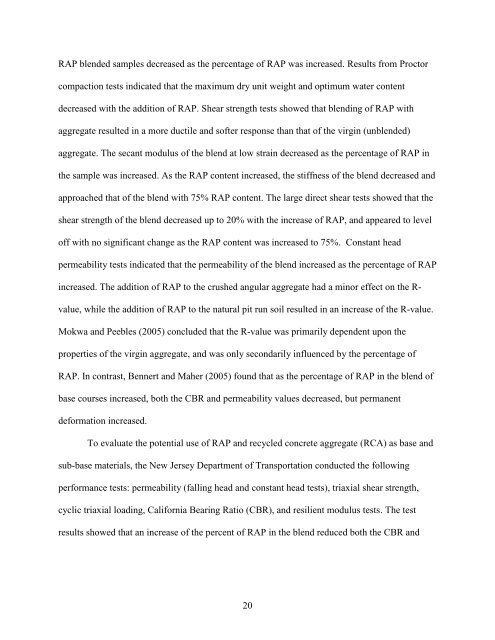Onsite Use of Recycled Asphalt Pavement Materials and Geocells to ...
Onsite Use of Recycled Asphalt Pavement Materials and Geocells to ...
Onsite Use of Recycled Asphalt Pavement Materials and Geocells to ...
Create successful ePaper yourself
Turn your PDF publications into a flip-book with our unique Google optimized e-Paper software.
RAP blended samples decreased as the percentage <strong>of</strong> RAP was increased. Results from Proc<strong>to</strong>r<br />
compaction tests indicated that the maximum dry unit weight <strong>and</strong> optimum water content<br />
decreased with the addition <strong>of</strong> RAP. Shear strength tests showed that blending <strong>of</strong> RAP with<br />
aggregate resulted in a more ductile <strong>and</strong> s<strong>of</strong>ter response than that <strong>of</strong> the virgin (unblended)<br />
aggregate. The secant modulus <strong>of</strong> the blend at low strain decreased as the percentage <strong>of</strong> RAP in<br />
the sample was increased. As the RAP content increased, the stiffness <strong>of</strong> the blend decreased <strong>and</strong><br />
approached that <strong>of</strong> the blend with 75% RAP content. The large direct shear tests showed that the<br />
shear strength <strong>of</strong> the blend decreased up <strong>to</strong> 20% with the increase <strong>of</strong> RAP, <strong>and</strong> appeared <strong>to</strong> level<br />
<strong>of</strong>f with no significant change as the RAP content was increased <strong>to</strong> 75%. Constant head<br />
permeability tests indicated that the permeability <strong>of</strong> the blend increased as the percentage <strong>of</strong> RAP<br />
increased. The addition <strong>of</strong> RAP <strong>to</strong> the crushed angular aggregate had a minor effect on the R-<br />
value, while the addition <strong>of</strong> RAP <strong>to</strong> the natural pit run soil resulted in an increase <strong>of</strong> the R-value.<br />
Mokwa <strong>and</strong> Peebles (2005) concluded that the R-value was primarily dependent upon the<br />
properties <strong>of</strong> the virgin aggregate, <strong>and</strong> was only secondarily influenced by the percentage <strong>of</strong><br />
RAP. In contrast, Bennert <strong>and</strong> Maher (2005) found that as the percentage <strong>of</strong> RAP in the blend <strong>of</strong><br />
base courses increased, both the CBR <strong>and</strong> permeability values decreased, but permanent<br />
deformation increased.<br />
To evaluate the potential use <strong>of</strong> RAP <strong>and</strong> recycled concrete aggregate (RCA) as base <strong>and</strong><br />
sub-base materials, the New Jersey Department <strong>of</strong> Transportation conducted the following<br />
performance tests: permeability (falling head <strong>and</strong> constant head tests), triaxial shear strength,<br />
cyclic triaxial loading, California Bearing Ratio (CBR), <strong>and</strong> resilient modulus tests. The test<br />
results showed that an increase <strong>of</strong> the percent <strong>of</strong> RAP in the blend reduced both the CBR <strong>and</strong><br />
20
















